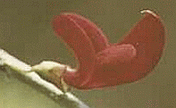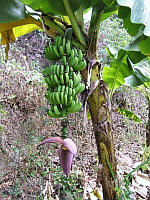
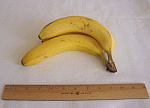
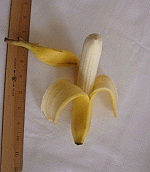
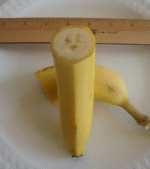
|
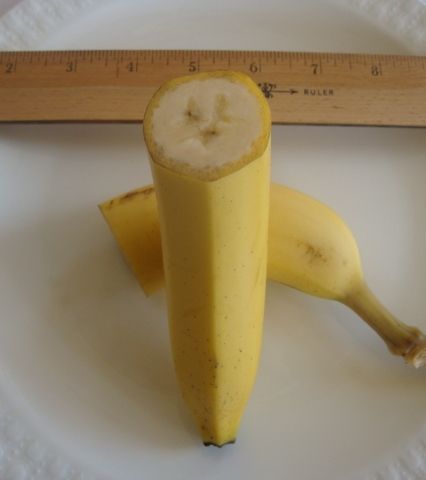
Davison Shillingford
Plant Family: Belongs to Musaceae or Banana family, which includes Plantains (M. balbisiana), Abaca or Manilla Hemp (Musa textilis) of the Phillipines, grown for its fibre, the Abyssinian banana (Ensete ventricosum), cultivated in Ethiopia for fiber and as a root crop, and the African Red banana (Musa ornata), an ornamental. [While there are numerous varieties of M. acuminata, our focus here is on the banana grown in the Roseau Botanic Gardens and widely grown in Dominica, the popular Cavendish or Lacatan banana of international trade.]
Description: World’s most popular fruit, the banana of commerce, is an elegant, herbaceous, quick growing, flowering plant, largest herb known, up to 7.6 m tall (25 ft), with soft, succulent, cylindrical pseudostem, up to 30 cm in diameter at base (12 in), consisting of sheathing leaf-stalks, growing from a basal corm; leave blade at top of pseudostem umbrella patterned and arranged spirally, handsome, dark green and oblong, up to 2.7 m long (9 ft) and 60 cm wide (2 ft); each pseudostem normally produces one terminal inflorescence, which quickly turns downward, bearing unisexual flowers - females first at top and males below; small male flowers borne at lower end of inflorescence under large bracts that drop quickly after opening; red succulent female bracts also drop quickly as ovaries grow into clusters (hands) of large, finger-like, seedless fruit; in the tall variety, Cavendish (Lacatan), fruit is ready for harvest about 3- 4 months after flower opens or about a year after planting; planting to harvest increasing with increase in average daily temperature; each tree normally bears one bunch of bananas weighing 50-80 lb average, each bunch 8-12 hands, each hand 12-16 bananas, each up to 25 cm long (10 in) and 4 cm in diameter (1.6 in); bananas harvested green about one week before ripening to facilitate transportation since ripened fruit susceptible to injury, trade then uses artificial ripening in export market; output about 10-15 tons per acre in well maintained fields; bananas usually turn yellow when ripe, and then easily peeled and eaten fresh; edible portion is pleasantly sweet and slightly acid with distinct “banana” bouquet; after fruiting, tree dies and is replaced by one or more suckers growing from the old corm; the Cavendish varieties, the familiar desert bananas, include the shorter and faster bearing Robusta, and the Giant Cavendish; other less common dessert bananas in Dominica include the large and rare Gros Michel, the small sweet, thin-skinned Sikiye or Silk banana, and the more mealy Red banana; edible bananas can be grouped into three broad types: the familiar desert banana – eaten green cooked, or ripe fresh when pulp rich in sugar; plantains – large, with pointed ends, starchy and usually cooked even when ripe, and cocoy – short and stubby, starchy, also cooked even when ripe; H.F. Macmillan said of the banana, “For productiveness combined with grandeur, [the banana] is without a rival in the vegetable kingdom.”
Natural Habitat: Requires hot moist climate; thrives on deep, fairly heavy soil in sheltered valleys; is highly susceptible to strong winds which uproot or break trees; fruiting is year round.
Origin and Distribution: Native to SE Asia and cultivated perhaps as early as 8000 BC; typically propagated from suckers springing from mother corm, and now also from tissue culture plantlets; a few varieties have seeds and these varieties used in breeding programs; banana now distributed to all parts of tropics and much of subtropics.
Uses: Cultivated primarily for its fruit, a staple of international trade and local consumption; one of the most prolific of all food crops, producing more than cassava, and several times as much as wheat and potatoes; eaten fresh when ripe or boiled when green, and boiled and mashed like potatoes; ripe bananas pureed for baby food; the edible pulp of ripe bananas contains about 70% water, carbohydrate 27%, protein 1.2 %, fat and fiber between 0.3% and 0.5 %; in Jamaica used for banana chips and banana flour; in SE Asia tender core of trunk eaten as vegetable similar to bamboo shoots, and male flowers eaten raw or cooked like artichoke; in Caribbean non export-quality bananas, ripe preferably, used to feed pigs; in Japan leaves and shoots yield fibre for high quality cloth; in Nepal trunk fibres used for making rugs with silk-like texture; bark fibres can be used for making paper; occasionally grown as ornamental in tropics, but is frequent ornamental in subtropics; peel and pulp of ripe bananas contain antifungal, antibiotic and dopamine factors; medicinally all parts used in folk medicine for wide range of ailments, including: stem pulp infusion for dysentery; leaves in poultices for burns and other skin ailments; flowers cooked for bronchitis, dysentery, diabetics and ulcers; ripe banana peel as abortive, and salve for insect stings and bites; ashes of unripe peel and leaves for dysentery, diarrhea and malignant ulcers; sap taken for epilepsy, leprosy, dysentery, diarrhea, and applied on insect stings and bites; root poultice for carbuncles, swellings, digestive disorders and dysentery.
Indigenous Legends and Anecdotes: In SE Asian folklore, a beautiful female ghost haunts banana trees, and people tie a length of satin cloth around stem to appease that spirit.
References:
Robert A. DeFilipps. Useful Plants of the Commonwealth of Dominica, West Indies. Smithsonian Institution, Washington, D.C. 1998
C.D. Adams. Flowering Plants of Jamaica. University of the West Indies, Mona, Glasgow University Press 1972
Julia F. Morton. Fruits of warm climates. Julia F. Morton, Miami, FL. 1987
H.F. Macmillan. Tropical Planting and Gardening. Macmillan, London 1956
Robert A. DeFilipps, et al. Medicinal Plants of the Guianas. Smithsonian Institution, Washington, D.C., draft October 2012 (http://botany.si.edu)
Bananas. Wikipedia, The Free Encyclopedia, October 2012 (en.wikipedia.org)
|

